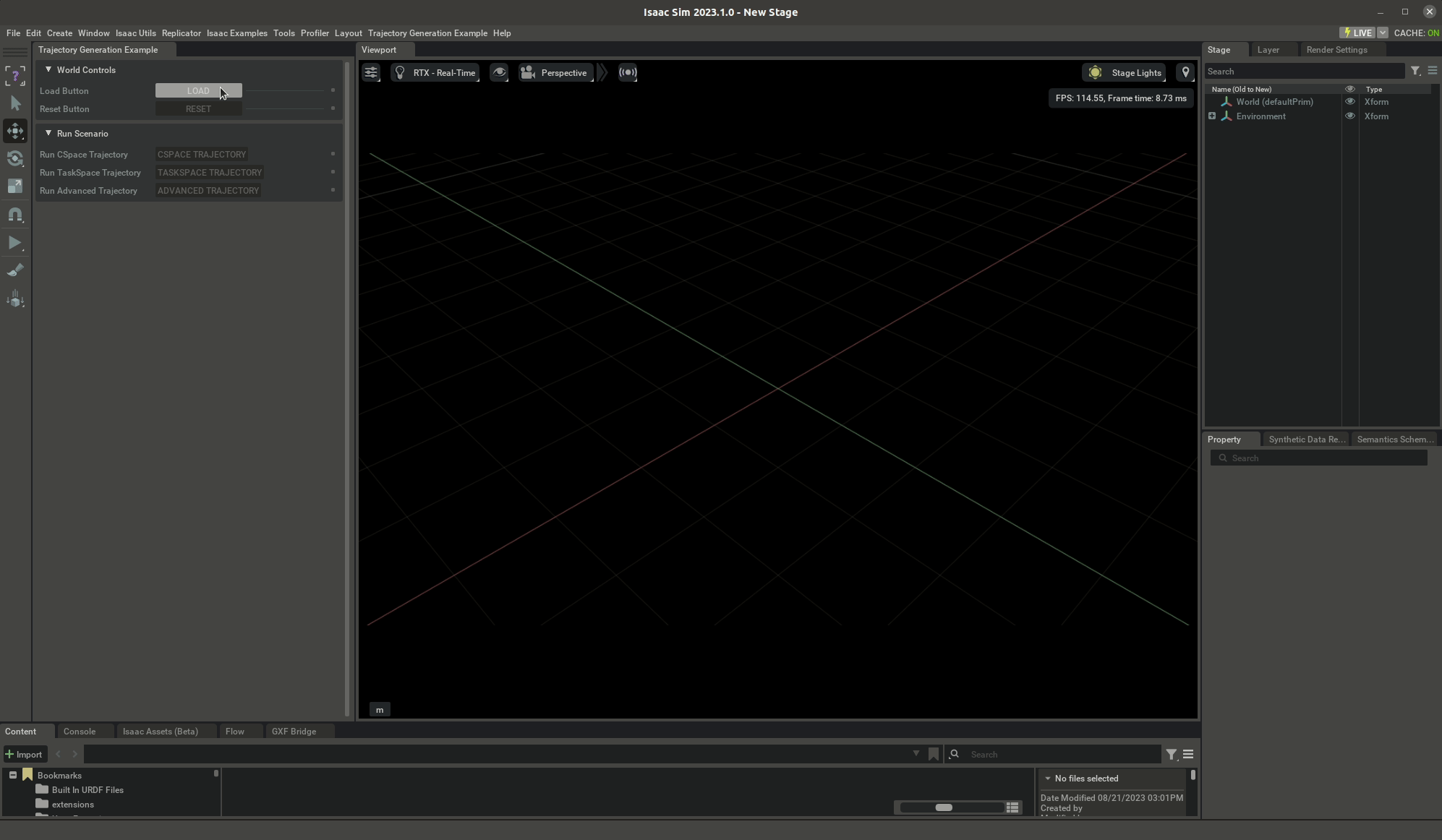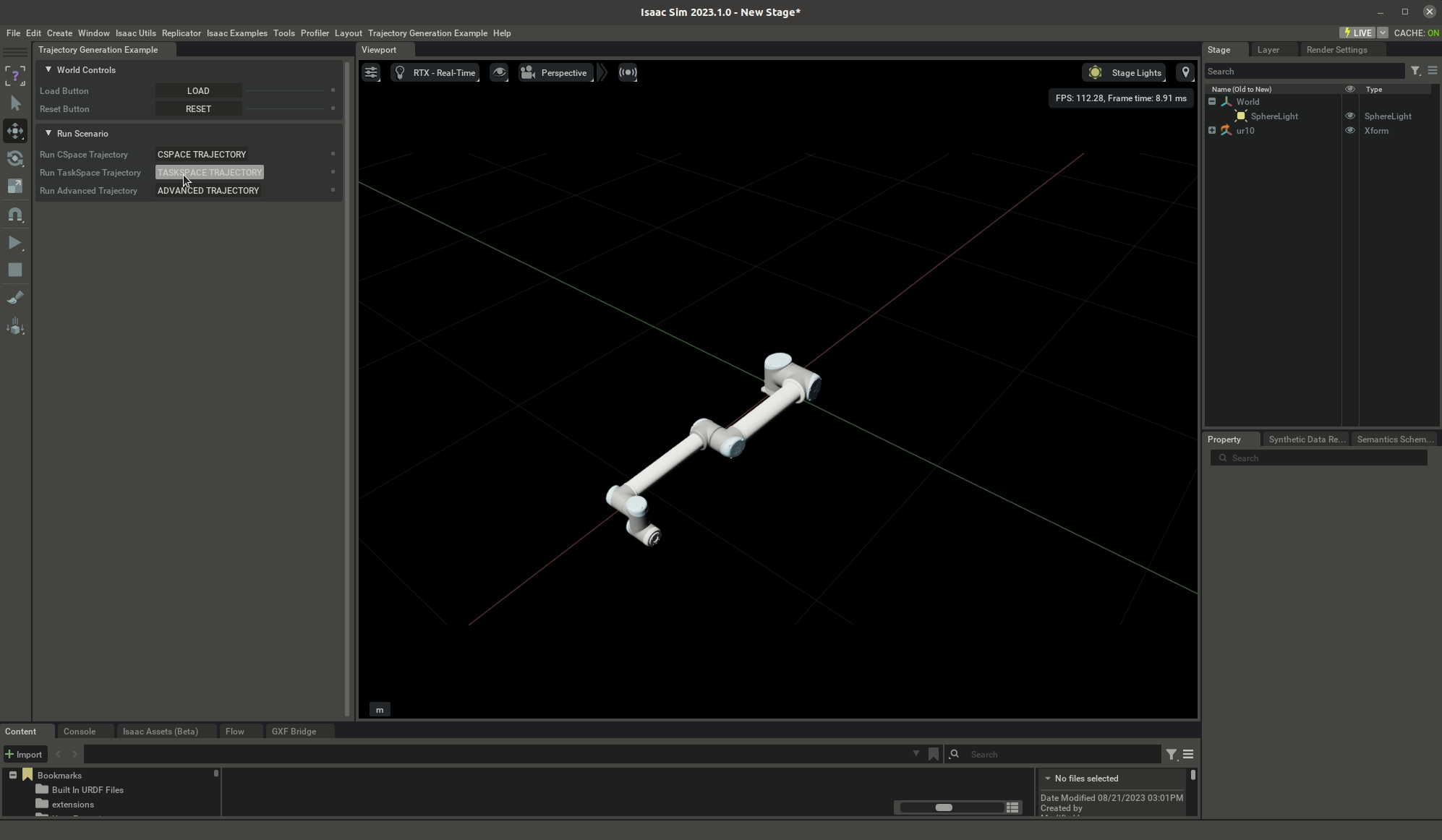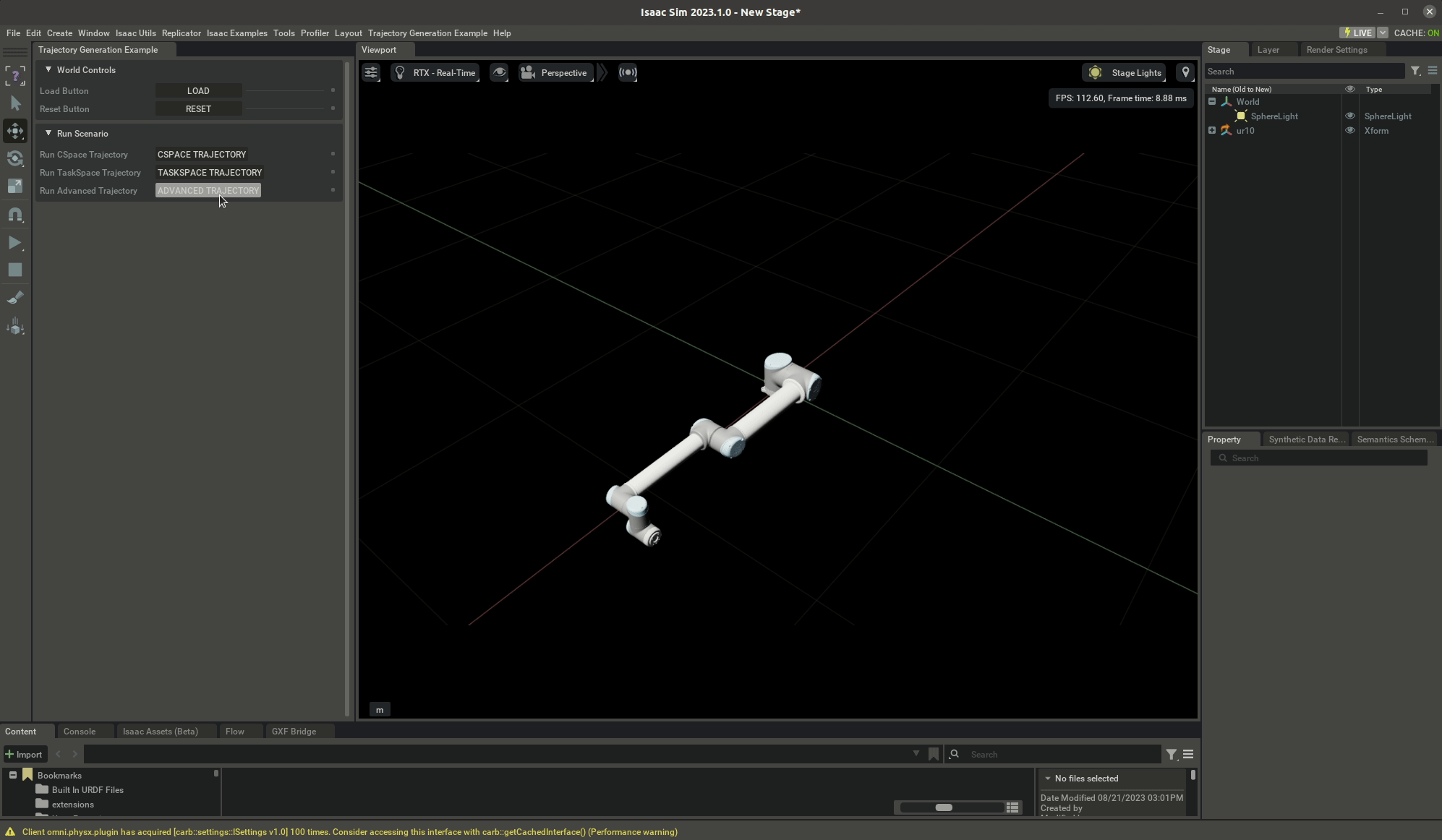Lula Trajectory Generator#
Learning Objectives#
This tutorial shows how the Lula Trajectory Generator in the Motion Generation extension can be used to create both task-space and c-space trajectories that can be easily applied to a simulated robot Articulation.
Getting Started#
Prerequisites
Please complete the Adding a Manipulator Robot tutorial prior to beginning this tutorial.
You may reference the Lula Robot Description and XRDF Editor to understand how to generate your own robot_description.yaml file to be able to use the Lula Trajectory Generator on unsupported robots.
Review the Loaded Scenario Extension Template to understand how this tutorial is structured and run.
In order to follow along with the tutorial, you may download a standalone Lula Trajectory Generator example extension here:
Lula Trajectory Generator Tutorial.
The provided zip file contains an example of the LulaTaskSpaceTrajectorygenerator and LulaCSpaceTrajectoryGenerator being used to generate trajectories
connecting specified c-space and task-space points.
This tutorial explains the contents of the file /Trajectory_Generator_python/scenario.py, which contains all trajectory generation code.
Generating a C-Space Trajectory#
The LulaCSpaceTrajectoryGenerator class is able to generate a trajectory that connects a provided set of c-space waypoints. The code snippet below demonstrates how, given appropriate config files, the LulaCSpaceTrajectoryGenerator class can be initialized and used to create a sequence of ArticulationAction that can be set on each frame to produce the desired trajectory.
The code snippet below shows the relevant contents of /Trajectory_Generator_python/scenario.py from the provided example.
1import numpy as np
2import os
3
4import carb
5from omni.isaac.core.utils.extensions import get_extension_path_from_name
6from omni.isaac.core.utils.stage import add_reference_to_stage
7from omni.isaac.core.articulations import Articulation
8from omni.isaac.core.utils.nucleus import get_assets_root_path
9from omni.isaac.core.objects.cuboid import FixedCuboid
10from omni.isaac.core.prims import XFormPrim
11from omni.isaac.core.utils.numpy.rotations import rot_matrices_to_quats
12from omni.isaac.core.utils.prims import delete_prim, get_prim_at_path
13
14from omni.isaac.motion_generation import (
15 LulaCSpaceTrajectoryGenerator,
16 LulaTaskSpaceTrajectoryGenerator,
17 LulaKinematicsSolver,
18 ArticulationTrajectory
19)
20
21import lula
22
23class UR10TrajectoryGenerationExample():
24 def __init__(self):
25 self._c_space_trajectory_generator = None
26 self._taskspace_trajectory_generator = None
27 self._kinematics_solver = None
28
29 self._action_sequence = []
30 self._action_sequence_index = 0
31
32 self._articulation = None
33
34 def load_example_assets(self):
35 # Add the Franka and target to the stage
36 # The position in which things are loaded is also the position in which they
37
38 robot_prim_path = "/ur10"
39 path_to_robot_usd = get_assets_root_path() + "/Isaac/Robots/UniversalRobots/ur10/ur10.usd"
40
41 add_reference_to_stage(path_to_robot_usd, robot_prim_path)
42 self._articulation = Articulation(robot_prim_path)
43
44 # Return assets that were added to the stage so that they can be registered with the core.World
45 return [self._articulation]
46
47 def setup(self):
48 # Config files for supported robots are stored in the motion_generation extension under "/motion_policy_configs"
49 mg_extension_path = get_extension_path_from_name("omni.isaac.motion_generation")
50 rmp_config_dir = os.path.join(mg_extension_path, "motion_policy_configs")
51
52 #Initialize a LulaCSpaceTrajectoryGenerator object
53 self._c_space_trajectory_generator = LulaCSpaceTrajectoryGenerator(
54 robot_description_path = rmp_config_dir + "/universal_robots/ur10/rmpflow/ur10_robot_description.yaml",
55 urdf_path = rmp_config_dir + "/universal_robots/ur10/ur10_robot.urdf"
56 )
57
58 self._taskspace_trajectory_generator = LulaTaskSpaceTrajectoryGenerator(
59 robot_description_path = rmp_config_dir + "/universal_robots/ur10/rmpflow/ur10_robot_description.yaml",
60 urdf_path = rmp_config_dir + "/universal_robots/ur10/ur10_robot.urdf"
61 )
62
63 self._kinematics_solver = LulaKinematicsSolver(
64 robot_description_path = rmp_config_dir + "/universal_robots/ur10/rmpflow/ur10_robot_description.yaml",
65 urdf_path = rmp_config_dir + "/universal_robots/ur10/ur10_robot.urdf"
66 )
67
68 self._end_effector_name = "ee_link"
69
70 def setup_cspace_trajectory(self):
71 c_space_points = np.array([
72 [-0.41 , 0.5 , -2.36 , -1.28 , 5.13 , -4.71 , ],
73 [-1.43 , 1.0 , -2.58 , -1.53 , 6.0 , -4.74 , ],
74 [-2.83 , 0.34 , -2.11 , -1.38 , 1.26 , -4.71 , ],
75 [-0.41 , 0.5 , -2.36 , -1.28 , 5.13 , -4.71 , ]
76 ])
77
78 timestamps = np.array([0,5,10,13])
79
80 trajectory_time_optimal = self._c_space_trajectory_generator.compute_c_space_trajectory(c_space_points)
81 trajectory_timestamped = self._c_space_trajectory_generator.compute_timestamped_c_space_trajectory(c_space_points,timestamps)
82
83 # Visualize c-space targets in task space
84 for i,point in enumerate(c_space_points):
85 position,rotation = self._kinematics_solver.compute_forward_kinematics(self._end_effector_name, point)
86 add_reference_to_stage(get_assets_root_path() + "/Isaac/Props/UIElements/frame_prim.usd", f"/visualized_frames/target_{i}")
87 frame = XFormPrim(f"/visualized_frames/target_{i}",scale=[.04,.04,.04])
88 frame.set_world_pose(position,rot_matrices_to_quats(rotation))
89
90 if trajectory_time_optimal is None or trajectory_timestamped is None:
91 carb.log_warn("No trajectory could be computed")
92 self._action_sequence = []
93 else:
94 physics_dt = 1/60
95 self._action_sequence = []
96
97 # Follow both trajectories in a row
98
99 articulation_trajectory_time_optimal = ArticulationTrajectory(self._articulation, trajectory_time_optimal, physics_dt)
100 self._action_sequence.extend(articulation_trajectory_time_optimal.get_action_sequence())
101
102 articulation_trajectory_timestamped = ArticulationTrajectory(self._articulation, trajectory_timestamped, physics_dt)
103 self._action_sequence.extend(articulation_trajectory_timestamped.get_action_sequence())
104
105 def update(self, step: float):
106 if len(self._action_sequence) == 0:
107 return
108
109 if self._action_sequence_index >= len(self._action_sequence):
110 self._action_sequence_index += 1
111 self._action_sequence_index %= len(self._action_sequence) + 10 # Wait 10 frames before repeating trajectories
112 return
113
114 if self._action_sequence_index == 0:
115 self._teleport_robot_to_position(self._action_sequence[0])
116
117 self._articulation.apply_action(self._action_sequence[self._action_sequence_index])
118
119 self._action_sequence_index += 1
120 self._action_sequence_index %= len(self._action_sequence) + 10 # Wait 10 frames before repeating trajectories
121
122 def reset(self):
123 # Delete any visualized frames
124 if get_prim_at_path("/visualized_frames"):
125 delete_prim("/visualized_frames")
126
127 self._action_sequence = []
128 self._action_sequence_index = 0
129
130 def _teleport_robot_to_position(self, articulation_action):
131 initial_positions = np.zeros(self._articulation.num_dof)
132 initial_positions[articulation_action.joint_indices] = articulation_action.joint_positions
133
134 self._articulation.set_joint_positions(initial_positions)
135 self._articulation.set_joint_velocities(np.zeros_like(initial_positions))
On lines 53-56, the LulaCSpaceTrajectoryGenerator class is initialized using a URDF and Lula Robot Description File. The LulaCSpaceTrajectoryGenerator takes in a series of waypoints, and it connects them in configuration space using spline-based interpolation. There are two main objectives that can be fulfilled by the trajectory generator: time-optimal and time-stamped.
The provided example shows a trajectory that runs quickly, and then runs slowly. This is seen in the code on lines (80-81 and 99-103). On line 80, a time-optimal trajectory is created in the form of a LulaTrajectory object, which fulfills the Trajectory Interface. On line 81, a time-stamped trajectory is created that will hit the same waypoints at the times [0,5,10,13] seconds (line 78). Time optimality is defined as saturating at least one of velocity, acceleration, or jerk limits of the robot throughout a trajectory.
On lines 99-103, These LulaTrajectory objects are passed to ArticulationTrajectory in order to generate a sequence of ArticulationAction that can be passed directly to the robot Articulation. The function ArticulationTrajectory.get_action_sequence() returns a list of ArticulationAction that is meant to be consumed at the specified rate. In this case, the framerate of physics is assumed to be fixed at 1/60 seconds.
If no trajectory can be computed that connects the c-space waypoints, the trajectory returned by LulaCSpaceTrajectoryGenerator.compute_c_space_trajectory will be None. This can occur when one of the specified c-space waypoints is not reachable or is very close to a joint limit. This case is handled on lines 90-92.
One lines 84-88, a visualization of the original c_space_points is created by converting them to task-space points. This code is not functional, but it helps to verify that the robot is hitting every target.
The update() function is programmed to play the sequence of ArticulationActions in a loop, taking a pause of 10 frames for dramatic effect between trajectories.

Generating a Task-Space Trajectory#
Simple Case: Linearly Connecting Waypoints#
Generating a task-space trajectory is similar to generating a c-space trajectory. In the simplest use-case, the user may pass in a set of task-space position and quaternion orientation targets, which will be linearly interpolated in task-space to produce the resulting trajectory. An example is provided in the code snippet below.
1class UR10TrajectoryGenerationExample():
2 def __init__(self):
3 self._c_space_trajectory_generator = None
4 self._taskspace_trajectory_generator = None
5 self._kinematics_solver = None
6
7 self._action_sequence = []
8 self._action_sequence_index = 0
9
10 self._articulation = None
11
12 def load_example_assets(self):
13 # Add the Franka and target to the stage
14 # The position in which things are loaded is also the position in which they
15
16 robot_prim_path = "/ur10"
17 path_to_robot_usd = get_assets_root_path() + "/Isaac/Robots/UniversalRobots/ur10/ur10.usd"
18
19 add_reference_to_stage(path_to_robot_usd, robot_prim_path)
20 self._articulation = Articulation(robot_prim_path)
21
22 # Return assets that were added to the stage so that they can be registered with the core.World
23 return [self._articulation]
24
25 def setup(self):
26 # Config files for supported robots are stored in the motion_generation extension under "/motion_policy_configs"
27 mg_extension_path = get_extension_path_from_name("omni.isaac.motion_generation")
28 rmp_config_dir = os.path.join(mg_extension_path, "motion_policy_configs")
29
30 #Initialize a LulaCSpaceTrajectoryGenerator object
31 self._c_space_trajectory_generator = LulaCSpaceTrajectoryGenerator(
32 robot_description_path = rmp_config_dir + "/universal_robots/ur10/rmpflow/ur10_robot_description.yaml",
33 urdf_path = rmp_config_dir + "/universal_robots/ur10/ur10_robot.urdf"
34 )
35
36 self._taskspace_trajectory_generator = LulaTaskSpaceTrajectoryGenerator(
37 robot_description_path = rmp_config_dir + "/universal_robots/ur10/rmpflow/ur10_robot_description.yaml",
38 urdf_path = rmp_config_dir + "/universal_robots/ur10/ur10_robot.urdf"
39 )
40
41 self._kinematics_solver = LulaKinematicsSolver(
42 robot_description_path = rmp_config_dir + "/universal_robots/ur10/rmpflow/ur10_robot_description.yaml",
43 urdf_path = rmp_config_dir + "/universal_robots/ur10/ur10_robot.urdf"
44 )
45
46 self._end_effector_name = "ee_link"
47
48 def setup_taskspace_trajectory(self):
49 task_space_position_targets = np.array([
50 [0.3, -0.3, 0.1],
51 [0.3, 0.3, 0.1],
52 [0.3, 0.3, 0.5],
53 [0.3, -0.3, 0.5],
54 [0.3, -0.3, 0.1]
55 ])
56
57 task_space_orientation_targets = np.tile(np.array([0,1,0,0]),(5,1))
58
59 trajectory = self._taskspace_trajectory_generator.compute_task_space_trajectory_from_points(
60 task_space_position_targets, task_space_orientation_targets, self._end_effector_name
61 )
62
63 # Visualize task-space targets in task space
64 for i,(position,orientation) in enumerate(zip(task_space_position_targets,task_space_orientation_targets)):
65 add_reference_to_stage(get_assets_root_path() + "/Isaac/Props/UIElements/frame_prim.usd", f"/visualized_frames/target_{i}")
66 frame = XFormPrim(f"/visualized_frames/target_{i}",scale=[.04,.04,.04])
67 frame.set_world_pose(position,orientation)
68
69 if trajectory is None:
70 carb.log_warn("No trajectory could be computed")
71 self._action_sequence = []
72 else:
73 physics_dt = 1/60
74 articulation_trajectory = ArticulationTrajectory(self._articulation, trajectory, physics_dt)
75
76 # Get a sequence of ArticulationActions that are intended to be passed to the robot at 1/60 second intervals
77 self._action_sequence = articulation_trajectory.get_action_sequence()
78
79 def update(self, step: float):
80 if len(self._action_sequence) == 0:
81 return
82
83 if self._action_sequence_index >= len(self._action_sequence):
84 self._action_sequence_index += 1
85 self._action_sequence_index %= len(self._action_sequence) + 10 # Wait 10 frames before repeating trajectories
86 return
87
88 if self._action_sequence_index == 0:
89 self._teleport_robot_to_position(self._action_sequence[0])
90
91 self._articulation.apply_action(self._action_sequence[self._action_sequence_index])
92
93 self._action_sequence_index += 1
94 self._action_sequence_index %= len(self._action_sequence) + 10 # Wait 10 frames before repeating trajectories
95
96 def reset(self):
97 # Delete any visualized frames
98 if get_prim_at_path("/visualized_frames"):
99 delete_prim("/visualized_frames")
100
101 self._action_sequence = []
102 self._action_sequence_index = 0
103
104 def _teleport_robot_to_position(self, articulation_action):
105 initial_positions = np.zeros(self._articulation.num_dof)
106 initial_positions[articulation_action.joint_indices] = articulation_action.joint_positions
107
108 self._articulation.set_joint_positions(initial_positions)
109 self._articulation.set_joint_velocities(np.zeros_like(initial_positions))
In moving to the task-space trajectory generator, there are few code changes required. The initialization is nearly the same on line 36 as for the c-space trajectory generator. The main changes are on lines 59-61 where a task-space trajectory is specified. When using the function LulaTaskSpaceTrajectoryGenerator.compute_task_space_trajectory_from_points, a position and orientation target must be specified for each task-space waypoint. Additionally, a frame from the robot URDF must be specified as the end effector frame. If the waypoints cannot be connected to form a trajectory, the compute_task_space_trajectory_from_points function will return None. This case is checked on line 69.

Defining Complicated Trajectories#
The LulaTaskSpaceTrajectoryGenerator can be used to create paths with more complicated specifications than to connect a set of task-space targets linearly. Using the class lula.TaskSpacePathSpec, the user may define paths with arcs and circles with multiple options for orientation targets. The code snippet below demonstrates creating a lula.TaskSpacePathSpec and gives an example of each available function for adding to a task-space path. Additionally, it shows how a lula.TaskSpacePathSpec can be combined with a lula.CSpacePathSpec in a lula.CompositePathSpec to specify trajectories that contain both c-space and task-space waypoints.
1class UR10TrajectoryGenerationExample():
2 def __init__(self):
3 self._c_space_trajectory_generator = None
4 self._taskspace_trajectory_generator = None
5 self._kinematics_solver = None
6
7 self._action_sequence = []
8 self._action_sequence_index = 0
9
10 self._articulation = None
11
12 def load_example_assets(self):
13 # Add the Franka and target to the stage
14 # The position in which things are loaded is also the position in which they
15
16 robot_prim_path = "/ur10"
17 path_to_robot_usd = get_assets_root_path() + "/Isaac/Robots/UniversalRobots/ur10/ur10.usd"
18
19 add_reference_to_stage(path_to_robot_usd, robot_prim_path)
20 self._articulation = Articulation(robot_prim_path)
21
22 # Return assets that were added to the stage so that they can be registered with the core.World
23 return [self._articulation]
24
25 def setup(self):
26 # Config files for supported robots are stored in the motion_generation extension under "/motion_policy_configs"
27 mg_extension_path = get_extension_path_from_name("omni.isaac.motion_generation")
28 rmp_config_dir = os.path.join(mg_extension_path, "motion_policy_configs")
29
30 #Initialize a LulaCSpaceTrajectoryGenerator object
31 self._c_space_trajectory_generator = LulaCSpaceTrajectoryGenerator(
32 robot_description_path = rmp_config_dir + "/universal_robots/ur10/rmpflow/ur10_robot_description.yaml",
33 urdf_path = rmp_config_dir + "/universal_robots/ur10/ur10_robot.urdf"
34 )
35
36 self._taskspace_trajectory_generator = LulaTaskSpaceTrajectoryGenerator(
37 robot_description_path = rmp_config_dir + "/universal_robots/ur10/rmpflow/ur10_robot_description.yaml",
38 urdf_path = rmp_config_dir + "/universal_robots/ur10/ur10_robot.urdf"
39 )
40
41 self._kinematics_solver = LulaKinematicsSolver(
42 robot_description_path = rmp_config_dir + "/universal_robots/ur10/rmpflow/ur10_robot_description.yaml",
43 urdf_path = rmp_config_dir + "/universal_robots/ur10/ur10_robot.urdf"
44 )
45
46 self._end_effector_name = "ee_link"
47
48 def setup_advanced_trajectory(self):
49 # The following code demonstrates how to specify a complicated cspace and taskspace path
50 # using the lula.CompositePathSpec object
51
52 initial_c_space_robot_pose = np.array([0,0,0,0,0,0])
53
54 # Combine a cspace and taskspace trajectory
55 composite_path_spec = lula.create_composite_path_spec(initial_c_space_robot_pose)
56
57 #############################################################################
58 # Demonstrate all the available movements in a taskspace path spec:
59
60 #Lula has its own classes for Rotations and 6 DOF poses: Rotation3 and Pose3
61 r0 = lula.Rotation3(np.pi/2, np.array([1.0, 0.0, 0.0]))
62 t0 = np.array([.3,-.1,.3])
63 task_space_spec = lula.create_task_space_path_spec(lula.Pose3(r0,t0))
64
65 # Add path linearly interpolating between r0,r1 and t0,t1
66 t1 = np.array([.3,-.1,.5])
67 r1 = lula.Rotation3(np.pi/3,np.array([1,0,0]))
68 task_space_spec.add_linear_path(lula.Pose3(r1, t1))
69
70 # Add pure translation. Constant rotation is assumed
71 task_space_spec.add_translation(t0)
72
73 # Add pure rotation.
74 task_space_spec.add_rotation(r0)
75
76 # Add three-point arc with constant orientation.
77 t2 = np.array([.3,.3,.3,])
78 midpoint = np.array([.3,0,.5])
79 task_space_spec.add_three_point_arc(t2, midpoint, constant_orientation=True)
80
81 # Add three-point arc with tangent orientation.
82 task_space_spec.add_three_point_arc(t0, midpoint, constant_orientation=False)
83
84 # Add three-point arc with orientation target.
85 task_space_spec.add_three_point_arc_with_orientation_target(lula.Pose3(r1, t2), midpoint)
86
87 # Add tangent arc with constant orientation. Tangent arcs are circles that connect two points
88 task_space_spec.add_tangent_arc(t0, constant_orientation=True)
89
90 # Add tangent arc with tangent orientation.
91 task_space_spec.add_tangent_arc(t2, constant_orientation=False)
92
93 # Add tangent arc with orientation target.
94 task_space_spec.add_tangent_arc_with_orientation_target(lula.Pose3(r0, t0))
95
96
97 ###################################################
98 # Demonstrate the usage of a c_space path spec:
99 c_space_spec = lula.create_c_space_path_spec(np.array([0,0,0,0,0,0]))
100
101 c_space_spec.add_c_space_waypoint(np.array([0 , 0.5 , -2.0 , -1.28 , 5.13 , -4.71]))
102
103
104 ##############################################################
105 #Combine the two path specs together into a composite spec:
106
107 # specify how to connect initial_c_space and task_space points with transition_mode option
108 transition_mode = lula.CompositePathSpec.TransitionMode.FREE
109 composite_path_spec.add_task_space_path_spec(task_space_spec, transition_mode)
110
111 transition_mode = lula.CompositePathSpec.TransitionMode.FREE
112 composite_path_spec.add_c_space_path_spec(c_space_spec, transition_mode)
113
114 #Transition Modes:
115 # lula.CompositePathSpec.TransitionMode.LINEAR_TASK_SPACE:
116 # Connect cspace to taskspace points linearly through task space. This mode is only available when adding a task_space path spec.
117 # lula.CompositePathSpec.TransitionMode.FREE:
118 # Put no constraints on how cspace and taskspace points are connected
119 # lula.CompositePathSpec.TransitionMode.SKIP:
120 # Skip the first point of the path spec being added, using the last pose instead
121
122
123 trajectory = self._taskspace_trajectory_generator.compute_task_space_trajectory_from_path_spec(
124 composite_path_spec, self._end_effector_name
125 )
126
127 if trajectory is None:
128 carb.log_warn("No trajectory could be computed")
129 self._action_sequence = []
130 else:
131 physics_dt = 1/60
132 articulation_trajectory = ArticulationTrajectory(self._articulation, trajectory, physics_dt)
133
134 # Get a sequence of ArticulationActions that are intended to be passed to the robot at 1/60 second intervals
135 self._action_sequence = articulation_trajectory.get_action_sequence()
136
137 def update(self, step: float):
138 if len(self._action_sequence) == 0:
139 return
140
141 if self._action_sequence_index >= len(self._action_sequence):
142 self._action_sequence_index += 1
143 self._action_sequence_index %= len(self._action_sequence) + 10 # Wait 10 frames before repeating trajectories
144 return
145
146 if self._action_sequence_index == 0:
147 self._teleport_robot_to_position(self._action_sequence[0])
148
149 self._articulation.apply_action(self._action_sequence[self._action_sequence_index])
150
151 self._action_sequence_index += 1
152 self._action_sequence_index %= len(self._action_sequence) + 10 # Wait 10 frames before repeating trajectories
153
154 def reset(self):
155 # Delete any visualized frames
156 if get_prim_at_path("/visualized_frames"):
157 delete_prim("/visualized_frames")
158
159 self._action_sequence = []
160 self._action_sequence_index = 0
161
162 def _teleport_robot_to_position(self, articulation_action):
163 initial_positions = np.zeros(self._articulation.num_dof)
164 initial_positions[articulation_action.joint_indices] = articulation_action.joint_positions
165
166 self._articulation.set_joint_positions(initial_positions)
167 self._articulation.set_joint_velocities(np.zeros_like(initial_positions))
The code snippet above creates a lula.CompositePathSpec on line 55 with an initial c-space position. It is combined with a lula.TaskSpacePathSpec on lines 108-109 and it is combined with a lula.CSpacePathSpec on lines 111-112. The resulting path is one that starts at the specified initial_c_space_robot_pose, then follows a series of taskspace targets, then hits two c-space targets. When combining path specs, a transition mode must be specified to determine how c-space and task-space points should be connected to each other. Reference lines 114-120 to see the possible options. In this case, no constraint is made on how the LulaTrajectoryGenerator connects these points.
Each available option for specifying a lula.TaskSpacePathSpec is demonstrated between lines 63-94. The code snippet above moves mainly between three translations: t0, t1, t2 with possible rotations r0, r1. The lula.TaskSpacePathSpec object is created with an initial position on line 63. Each following add function that is called adds a path between the last position in the path_spec so far and a new position. The basic possibilities are:
Linearly interpolate translation to a new point while keeping rotation fixed (line 71)
Linearly interpolate rotation to a new point while keeping translation fixed (line 74)
Linearly interpolate both rotation and translation to a new 6 DOF point (line 68)
The lula.TaskSpacePathSpec also makes it easy to define various arcs and circular paths that connect points in space. A three-point arc can be defined that moves through a midpoint to a translation target. There are three options for the orientation of the robot while moving along the path:
Keep rotation constant (line 79)
Always stay oriented tangent to the arc (line 82)
Linearly interpolate rotation to a rotation target (line 85)
Finally, a circular path may be specified without defining a midpoint as on lines 88, 91, and 94. The same three options for specifying orientation are available.

Summary#
This tutorial shows how to use the Lula Trajectory Generator to generate c-space and task-space trajectories for a robot. Task-space trajectories may be specified simply using a series of task-space waypoints that will be connected linearly, or they may be defined piecewise with many different options for connecting each pair of points in space.
Further Learning#
Reference the Motion Generation page for a complete description of trajectories in Omniverse Isaac Sim.